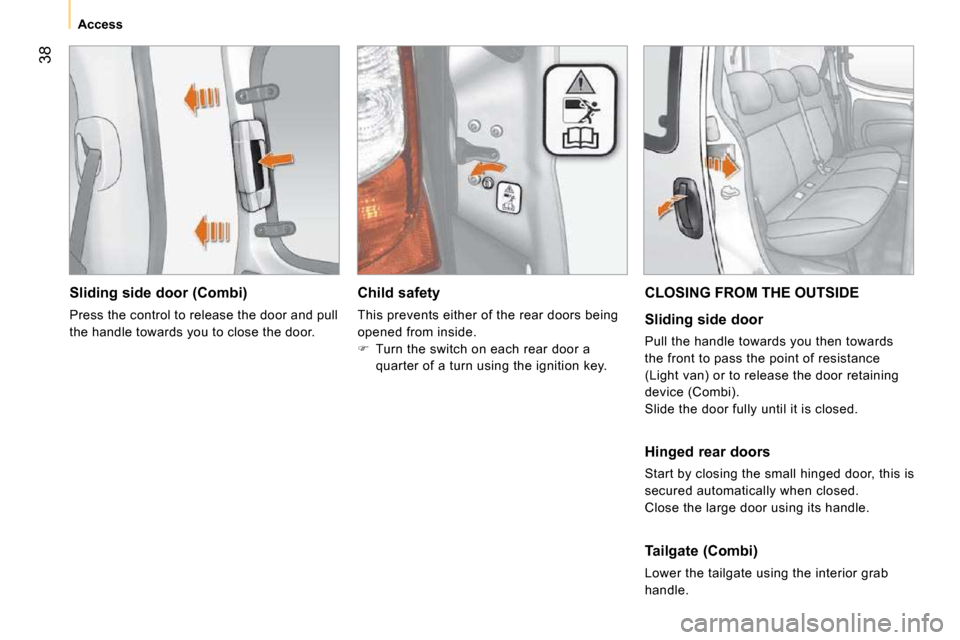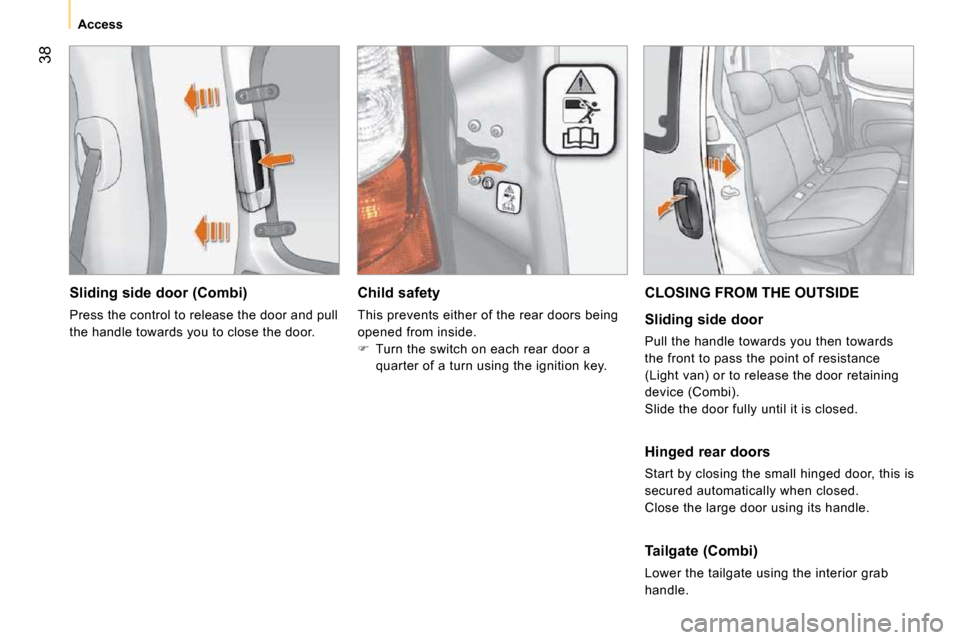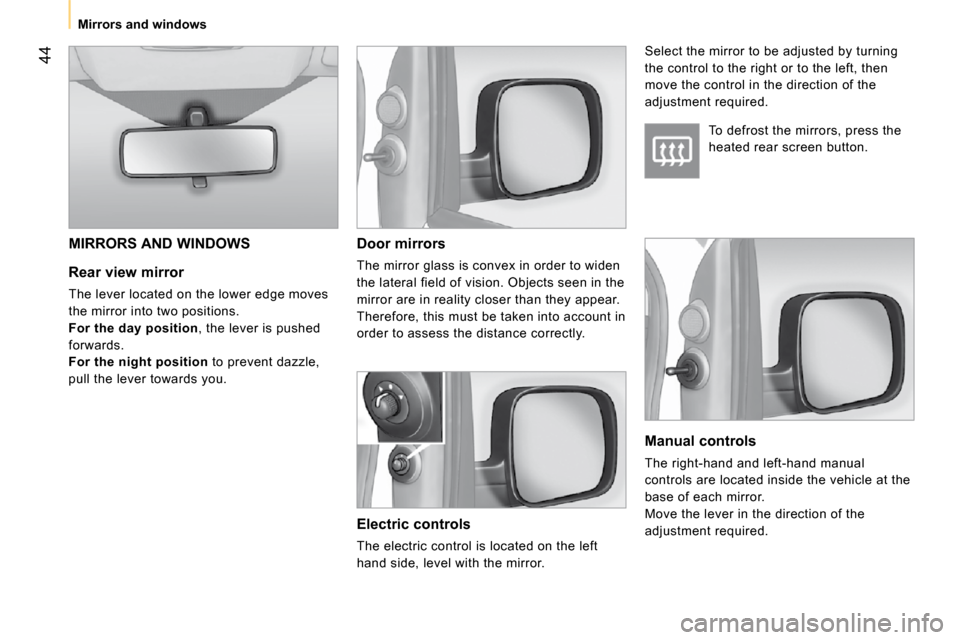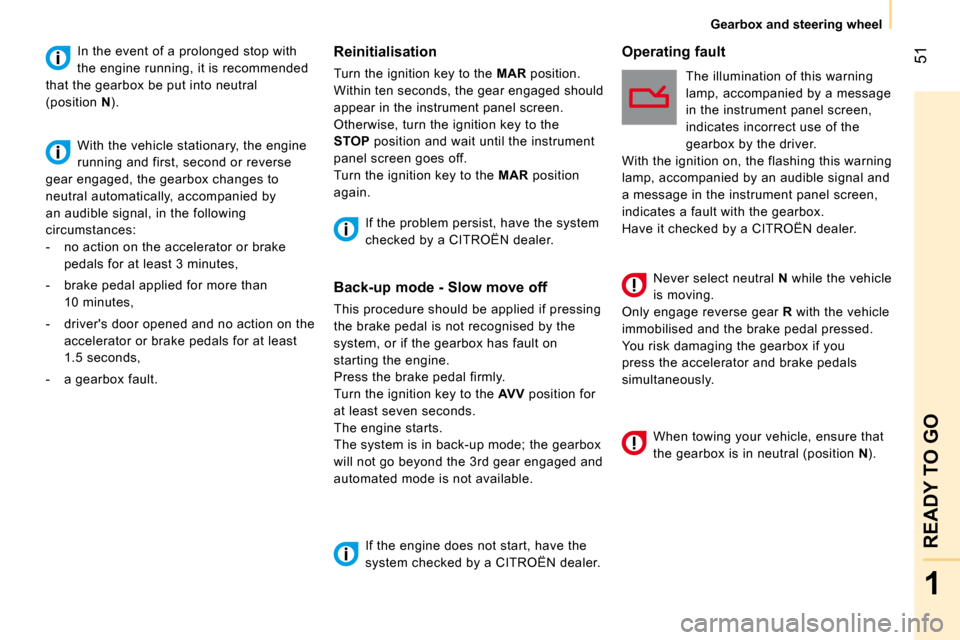tow Citroen NEMO 2010.5 1.G User Guide
[x] Cancel search | Manufacturer: CITROEN, Model Year: 2010.5, Model line: NEMO, Model: Citroen NEMO 2010.5 1.GPages: 166, PDF Size: 4.22 MB
Page 44 of 166

38
Access
Sliding side door (Combi)
Press the control to release the door and pull
the handle towards you to close the door. Child safety
This prevents either of the rear doors being
opened from inside.
�� Turn the switch on each rear door a
quarter of a turn using the ignition key. CLOSING FROM THE OUTSIDE
Sliding side door
Pull the handle towards you then towards
the front to pass the point of resistance
(Light van) or to release the door retaining
device (Combi).
Slide the door fully until it is closed.
Hinged rear doors
Start by closing the small hinged door, this is
secured automatically when closed.
Close the large door using its handle.
Tailgate (Combi)
Lower the tailgate using the interior grab
handle.
Page 45 of 166

38
Access
Sliding side door (Combi)
Press the control to release the door and pull
the handle towards you to close the door. Child safety
This prevents either of the rear doors being
opened from inside.
�� Turn the switch on each rear door a
quarter of a turn using the ignition key. CLOSING FROM THE OUTSIDE
Sliding side door
Pull the handle towards you then towards
the front to pass the point of resistance
(Light van) or to release the door retaining
device (Combi).
Slide the door fully until it is closed.
Hinged rear doors
Start by closing the small hinged door, this is
secured automatically when closed.
Close the large door using its handle.
Tailgate (Combi)
Lower the tailgate using the interior grab
handle.
Page 46 of 166

39
1
READY TO GO
Steering mounted controls
LIGHTING STALK
Selection is by rotation of the white mark
on the ring, when the ignition key is in the
RUNNING position.
All lamps off
Sidelamps on
This is indicated on the instrument
panel by lighting of the warning lamp.
Dipped headlamps/main beam
headlamps on
Dipped headlamps/main beam
headlamps change
Pull the lighting stalk fully towards you. Headlamp flash
Direction indicators "Motorway" function
System which indicates a change of lane on
high-speed roads.
Press the lighting stalk up or down once,
without passing the point of resistance; the
corresponding direction indicators will flash
three times.
Pull the lighting stalk towards you
gently, regardless of the position
of the ring. Left: push downwards. The green
direction arrow warning lamp
flashes on the instrument panel.
Right: push upwards. The green
direction arrow warning lamp flashes on the
instrument panel. Turn the ring into position.
Parking lamps
Side markers for the vehicle by illumination
of the sidelamps on the traffic side only.
Ignition key in the STOP position or removed
from the ignition switch:
� turn the ring to the "Lighting off" position,
then to the "Sidelamps" position,
� operate the lighting control stalk up
or down depending on the traffic side
(for example: when parking on the left;
lighting control stalk upwards; the right
hand sidelamps are on).
This is confirmed by illumination of the
sidelamps warning lamp in the instrument
panel.
To switch off the parking lamps, return the
lighting control stalk to the middle position
and the ring to the "Lighting off" position.
Page 47 of 166

40
Steering mounted controls Headlamp beam
You are advised to adjust the height of the
headlamp beams in accordance with the
load in your vehicle.
This function can only be accessed in
the main beam headlamps and dipped
headlamps position.
Press these controls, located
on the fascia panel, several
times in succession to adjust the
headlamps.
Fog lamps
The controls are located on the fascia panel
control pad.
Front and rear fog lamps
The fog lamps should only be used in
fog or when snow is falling.
In clear weather or in rain, both day and
night, lit rear fog lamps dazzle and are
prohibited.
Do not forget to switch them off when they
are no longer necessary. Guide-me-home lighting
The temporary maintaining of the dipped
headlamps, after switching off the vehicle's
ignition, makes the driver's exit easier when
the light is poor and lights the space in front
of the vehicle.
Activation
With the ignition key in the STOP position
or removed, pull the lighting stalk towards
the steering wheel within 2 minutes after
switching off the engine.
Each time the control is operated, the
duration for which the lamps will remain
on is extended by 30 seconds, up to a
maximum of 210 seconds. Once this period
of time has elapsed, the lamps switch off
automatically.
Deactivation
Pull the lighting stalk towards the steering
wheel for more than 2 seconds.
The front fog lamps operate with
the side lights and the dipped
headlamps.
The rear fog lamps operate with
the dipped headlamps.
Press one of these controls to switch on the
lights. The warning lamp comes on,
accompanied by a message
on the display, the first time
the control is operated and
remains on until the function is deactivated
automatically. An indicator light on the display
indicates the adjustment position
selected (0, 1, 2, 3).
Page 48 of 166

40
Steering mounted controls Headlamp beam
You are advised to adjust the height of the
headlamp beams in accordance with the
load in your vehicle.
This function can only be accessed in
the main beam headlamps and dipped
headlamps position.
Press these controls, located
on the fascia panel, several
times in succession to adjust the
headlamps.
Fog lamps
The controls are located on the fascia panel
control pad.
Front and rear fog lamps
The fog lamps should only be used in
fog or when snow is falling.
In clear weather or in rain, both day and
night, lit rear fog lamps dazzle and are
prohibited.
Do not forget to switch them off when they
are no longer necessary. Guide-me-home lighting
The temporary maintaining of the dipped
headlamps, after switching off the vehicle's
ignition, makes the driver's exit easier when
the light is poor and lights the space in front
of the vehicle.
Activation
With the ignition key in the STOP position
or removed, pull the lighting stalk towards
the steering wheel within 2 minutes after
switching off the engine.
Each time the control is operated, the
duration for which the lamps will remain
on is extended by 30 seconds, up to a
maximum of 210 seconds. Once this period
of time has elapsed, the lamps switch off
automatically.
Deactivation
Pull the lighting stalk towards the steering
wheel for more than 2 seconds.
The front fog lamps operate with
the side lights and the dipped
headlamps.
The rear fog lamps operate with
the dipped headlamps.
Press one of these controls to switch on the
lights. The warning lamp comes on,
accompanied by a message
on the display, the first time
the control is operated and
remains on until the function is deactivated
automatically. An indicator light on the display
indicates the adjustment position
selected (0, 1, 2, 3).
Page 52 of 166

44
Mirrors and windows
Rear view mirror
The lever located on the lower edge moves
the mirror into two positions.
For the day position , the lever is pushed
forwards.
For the night position to prevent dazzle,
pull the lever towards you. Door mirrors
The mirror glass is convex in order to widen
the lateral field of vision. Objects seen in the
mirror are in reality closer than they appear.
Therefore, this must be taken into account in
order to assess the distance correctly.
Electric controls
The electric control is located on the left
hand side, level with the mirror.
MIRRORS AND WINDOWS
To defrost the mirrors, press the
heated rear screen button.
Select the mirror to be adjusted by turning
the control to the right or to the left, then
move the control in the direction of the
adjustment required.
Manual controls
The right-hand and left-hand manual
controls are located inside the vehicle at the
base of each mirror.
Move the lever in the direction of the
adjustment required.
Page 56 of 166

48
Gearbox and steering wheel
ELECTRONIC GEARBOX
The five-speed electronic gearbox offers a
choice between the comfort of automated
operation or the pleasure of manual gear
changing.
This gearbox provides two driving modes:
- an automated mode for automatic control of the gears by the gearbox and therefore
without any action on the part of the driver,
- a sequential mode for manual changing of the gears by the driver using the gear
lever.
It consists of:
1. a gear lever 1 on the centre console
for selecting the driving mode, reverse
gear and neutral or for changing gear in
sequential mode,
2. a button 2 to activate or deactivate the
economy programme. Gear lever gate
All movements of the gear lever are given
from the middle position.
N : neutral.
With your foot on the brake, select this
position to start, by moving the gear lever to
the right and then forwards.
R : reverse gear.
With the vehicle stationary, keep your foot
on the brake pedal and move the gear lever
to the right and then backwards.
M +/-: sequential mode with manual gear
changing.
Make a long push to the left on the lever to
select this mode, then:
- push towards + to change up,
- push towards - to change down. Displays in the instrument panel
N. Neutral.
R. Reverse.
1 2 3 4 5. Gears engaged.
AUTO. Comes on when automated mode
is selected; it goes out when changing to
sequential mode.
E. It comes on when the economy
programme is activated; it goes off on
deactivation.
A : automated mode.
Move the lever downwards to select this
mode.
E : economy programme.
Press this button to activate or deactivate it.
Page 57 of 166

49
1
READY TO GO
Gearbox and steering wheel
Moving off
You must press the brake pedal.
Start the engine; the gearbox changes into
neutral automatically.
the gear lever stays in the position selected
before switching off the ignition.
"N" appears in the instrument panel screen,
accompanied by an audible signal, to
indicate that there is a difference between
the position of the gear lever and the gear
selected in the gearbox.
Select first gear (move the lever towards + )
or reverse (position R ).
Release the parking brake.
Remove your foot from the brake pedal and
then accelerate away.
"1" or "R" appears in the instrument panel
screen. It is also possible to move off in 2nd
gear on slippery surfaces.
Stopping - Starting on a slope
This gearbox is an electronic gearbox which
does not have a clutch pedal.
Do not use the accelerator pedal to
immobilise the vehicle on a slope, apply
the parking brake instead; failure to
follow this procedure can overheat the
clutch and damage the gearbox .
When moving off on a slope, accelerate
gradually while releasing the parking brake. By rapidly pushing the accelerator fully
done, the vehicle moves off quickly.
Automated mode
Once you have moved off, you can switch to
automated mode by selecting position
A/M .
"AUTO" and the gear engaged
appear in the instrument panel
screen.
The gearbox then operates in auto-active
mode, without any action on the part of the
driver.
It continuously selects the most appropriate
gear depending on the:
- vehicle speed,
- engine speed,
- accelerator pedal position.
To optimise driving comfort and obtain the
most suitable gear, avoid sharp variations in
the pressure on the accelerator pedal.
If you press the accelerator pedal beyond
the point of resistance, the gearbox changes
down for sharper acceleration.
Page 59 of 166

51
1
READY TO GO
Gearbox and steering wheel
Reinitialisation
Turn the ignition key to the MAR position.
Within ten seconds, the gear engaged should
appear in the instrument panel screen.
Otherwise, turn the ignition key to the
STOP position and wait until the instrument
panel screen goes off.
Turn the ignition key to the MAR position
again. The illumination of this warning
lamp, accompanied by a message
in the instrument panel screen,
indicates incorrect use of the
gearbox by the driver.
With the ignition on, the flashing this warning
lamp, accompanied by an audible signal and
a message in the instrument panel screen,
indicates a fault with the gearbox.
Have it checked by a CITROËN dealer.
If the problem persist, have the system
checked by a CITROËN dealer.
Never select neutral N while the vehicle
is moving.
Only engage reverse gear R with the vehicle
immobilised and the brake pedal pressed.
You risk damaging the gearbox if you
press the accelerator and brake pedals
simultaneously.
Back-up mode - Slow move off
This procedure should be applied if pressing
the brake pedal is not recognised by the
system, or if the gearbox has fault on
starting the engine.
Press the brake pedal firmly.
Turn the ignition key to the
AVV position for
at least seven seconds.
The engine starts.
The system is in back-up mode; the gearbox
will not go beyond the 3 rd gear engaged and
automated mode is not available.
If the engine does not start, have the
system checked by a CITROËN dealer. Operating fault
In the event of a prolonged stop with
the engine running, it is recommended
that the gearbox be put into neutral
(position N ).
With the vehicle stationary, the engine
running and first, second or reverse
gear engaged, the gearbox changes to
neutral automatically, accompanied by
an audible signal, in the following
circumstances:
- no action on the accelerator or brake pedals for at least 3 minutes,
- brake pedal applied for more than 10 minutes,
- driver's door opened and no action on the accelerator or brake pedals for at least
1.5 seconds,
- a gearbox fault.
When towing your vehicle, ensure that
the gearbox is in neutral (position N ).
Page 78 of 166

Parking sensors
REAR PARKING SENSORS
The audible system consists of four
proximity sensors, fitted in the rear bumper.
It detects any obstacle which enters the
field: person, vehicle, tree, fence, behind the
vehicle during the manoeuvre.
However, it will not be able to detect
obstacles located immediately below the
bumper.
An object, such as a stake, a roadworks
cone or any other similar object may be
detected at the beginning of the manoeuvre
but may no longer be detected when the
vehicle moves close to it.
This system does not take the place of the
vigilance and responsibility of the driver. Stop the assistance
Change to neutral.
Operating fault
If this warning lamp or the service
warning lamp comes on in the
instrument panel, accompanied
by a message in the screen,
contact a CITROËN dealer.
Good practice
In bad weather or in winter, ensure that the
sensors are not covered with mud, ice or
snow.
Engage reverse gear
The proximity information is indicated by an
audible signal which becomes more rapid as
the vehicle approaches the obstacle.
When the distance between the rear of
the vehicle and the obstacle is less than
approximately thirty centimetres, the audible
signal becomes continuous.
This function will be deactivated
automatically if a trailer is being towed.
You are advised to obtain a towbar
recommended by CITROËN and have it
installed by a professional.
If anomalies are detected on engaging reverse
gear, the warning lamp comes on, possibly
accompanied by a message in the screen.
7070